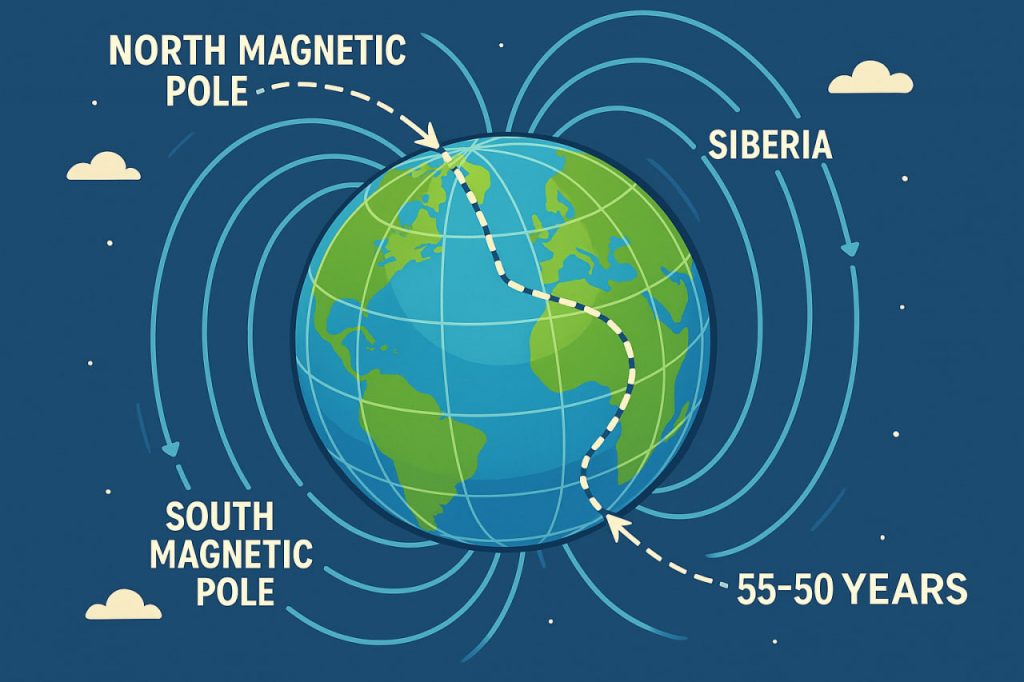The magnetic field of the Earth protects our planet from solar radiation and cosmic particles. It is generated by the movement of molten iron in the outer core. Over the past 50 years, scientists have observed significant shifts of the magnetic poles, showing that Earth’s magnetic system is dynamic and constantly changing.
Observed Pole Movements
Data from satellites and ground observatories show that the North Magnetic Pole has moved thousands of kilometers. In the 1970s, it was located in the Canadian Arctic, but since then it has rapidly drifted toward Siberia, moving at speeds of up to 40–55 kilometers per year. The South Magnetic Pole has also shifted, although less dramatically, moving gradually across Antarctica.
Causes of the Shift
The shifts are linked to changes in the fluid dynamics of the outer core. Flows of molten iron alter the distribution of the magnetic field, creating areas of stronger or weaker magnetism. Scientists use complex models of geodynamo processes to track and predict these changes.
Implications for Navigation
Shifts in magnetic poles directly affect compasses, aircraft navigation, and shipping routes. To maintain accuracy, international organizations regularly update the World Magnetic Model (WMM), which is used in GPS systems, military applications, and everyday navigation tools.
Potential Long-Term Effects
Though pole shifts are natural, they may signal deeper changes in Earth’s magnetic field. Some scientists suggest that these movements could be early signs of a geomagnetic reversal, when the North and South poles swap places. Such events have occurred many times in Earth’s history, though on timescales of thousands of years.
Modern Monitoring Technologies
Today, satellites like ESA’s Swarm constellation provide high-resolution measurements of the magnetic field. Combined with ground observatories, these data allow scientists to monitor pole movements in real time and improve predictive models.
Conclusion
The last 50 years have shown that Earth’s magnetic poles are far from fixed—they are constantly moving due to processes deep within the planet. While these shifts have practical effects on navigation, they are also valuable scientific indicators of the dynamic nature of Earth’s interior.
Changes in the magnetic field are one of the links in the large-scale processes of climate change on the planet, and only by working together as a united humanity can we overcome this period.
Interesting Facts
Over the past 50 years, Earth’s magnetic poles have been moving at unprecedented speeds, revealing fascinating details about our planet’s core dynamics. The magnetic north pole, once located in northern Canada, has migrated more than 2,000 kilometers toward Siberia, traveling at a pace of up to 55 kilometers per year in the early 2000s — the fastest recorded in modern history. This motion is linked to complex flows of molten iron in the outer core, which continuously reshape the magnetic field. In contrast, the magnetic south pole has shifted more slowly, creating a noticeable asymmetry between hemispheres. These changes have required periodic updates to the World Magnetic Model (WMM), used in navigation systems such as GPS, aviation, and even smartphone compasses. Interestingly, despite these shifts, the overall magnetic field strength has weakened by about 9% since the 19th century, especially in the region known as the South Atlantic Anomaly, where satellites experience increased radiation exposure.
Glossary
- Magnetic field – invisible field around Earth created by movement of molten iron in the outer core.
- Geomagnetic reversal – event in which Earth’s magnetic north and south poles switch places.
- Geodynamo – physical process that generates Earth’s magnetic field.
- World Magnetic Model (WMM) – global model used for navigation and GPS corrections.
- Outer core – liquid layer of Earth composed mainly of molten iron and nickel.
- Swarm constellation – a group of satellites designed to study Earth’s magnetic field.


